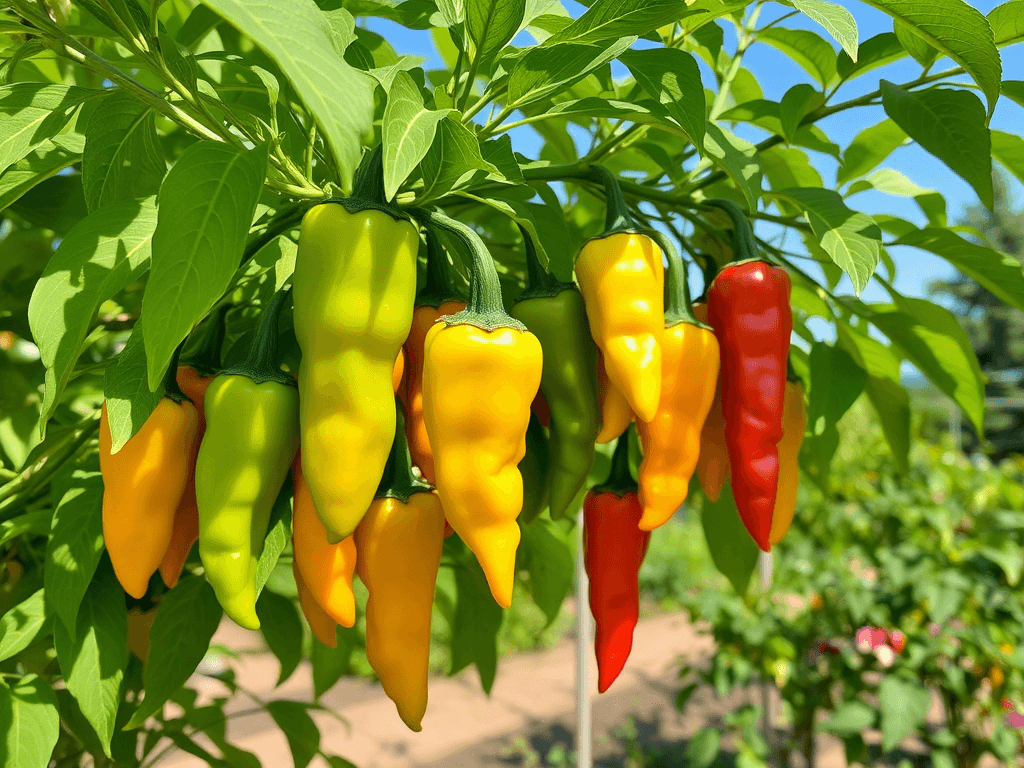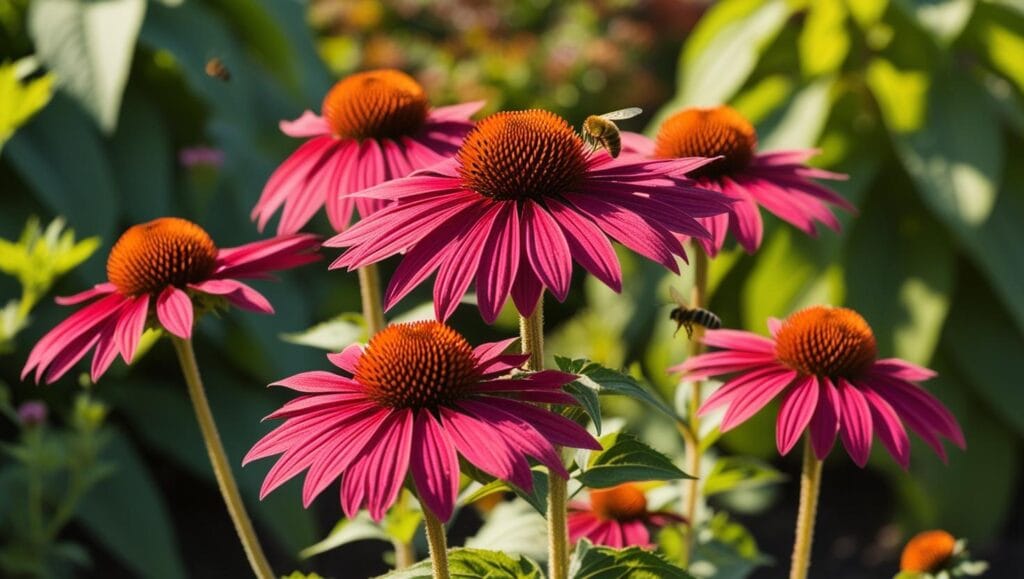Last summer, my cucumber plants were under siege—aphids, powdery mildew. That’s when I discovered the magic of companion planting.
By choosing the right companion, you can boost yields, prevent pests like cucumber beetles, and create a vegetable garden that hums with life.
Let’s break down the best cucumber companion plants (and the ones to avoid) so your cucumbers thrive this season.
Table of Contents
Why Your Cucumber Plants Need Friends (And Enemies)
Companion planting isn’t just about tossing seeds together. It’s about curating a garden ecosystem. Cucumbers are heavy feeders that need nutrients in the soil and space for their cucumber vines to climb. The right plants near cucumbers can:
- Repel cucumber beetles and pests like aphids.
- Fix nitrogen in the soil (thanks to legumes like beans and peas).
- Provide natural trellises (hello, sunflower stalks!).

But if you pair them with bad companion plants like potatoes, tomatoes, melons, and watermelons, you’ll spark a pest-and-disease war.
Best Companion Plants for Cucumbers
1. Sunflowers
Sunflowers aren’t just pretty—they’re a great companion plant for cucumbers. Their tall, sturdy stalks let cucumber vines climb, improving airflow. Plant them on the north side of your cucumber bed to avoid shading.

Tip: Choose varieties like ‘Mammoth Grey Stripe’—their thick stems handle cucumber vines like champs.
Sunflowers act as natural trellises, keeping cucumber leaves off the damp ground. This reduces the risk of fungal diseases like powdery mildew. Their large blooms also attract pollinators like bees, improving fruit set.
How to Plant
Sow sunflower seeds 1 inch deep and 6 inches apart. Once they reach 12–18 inches tall, help cucumber vines to climb by loosely tying them to the stalks with soft garden twine.
2. Nasturtiums
These bright flowers are excellent companions for cucumbers. Nasturtiums prevent cucumber beetles and lure aphids away from your cucumber plants. Plus, their edible blooms add a peppery zing to salads.

Warning: They grow very fast! Trim them weekly to avoid a neon-orange takeover.
Nasturtiums emit a mustard oil that pests find irresistible. Aphids and beetles flock to them, sparing your cucumbers. They also attract predatory insects like ladybugs, which feast on pests.
How to Plant
Scatter nasturtium seeds around the perimeter of your cucumber patch. For interplanting, space them 8–12 inches apart. They thrive in poor soil—avoid fertilizing, or you’ll get more leaves than flowers.
3. Beans and Peas
Beans and peas are a vegetable garden staple. They pump nitrogen into the soil, fueling the leafy growth of cucumber plants. Plant them between cucumber mounds.

Beans have a symbiotic relationship with rhizobia bacteria in their roots, which convert atmospheric nitrogen into a form cucumbers can absorb.
How to Plant
Sow bean and pea seeds 1 inch deep and 4 inches apart. To avoid crowding, keep them 12 inches away from cucumber roots.
4. Marigolds and Calendula
Marigolds (Tagetes) produce chemicals (alpha-terthienyl) that are toxic to root-knot that kill nematodes, tiny worms that attack cucumber roots. (Marigolds are not harmful to people and plants.) They also repel whiteflies and squash bugs.
Plant them in groups around your cucumber companion plants for a pest-free zone.

Their blooms attract hoverflies, which devour aphids.
How to Plant
Start marigold and calendula seeds indoors 6–8 weeks before the last frost. Transplant them 10–12 inches apart around cucumber mounds.
5. Root Vegetables (Carrots, Radishes, Beets)
Grow them underground so they don’t compete for space. Sow radish seeds alongside cucumbers—they mature in 25 days, breaking up the soil and deterring beetles. After the harvest, their decaying roots feed cucumbers during the season.

Radishes act as a “trap crop” for flea and cucumber beetles. Their fast growth also reduces compacted soil, improving drainage.
How to Plant
Plant radish seeds ½ inch deep and 2 inches apart between cucumber rows. Harvest them when the roots are 1 inch in diameter.
6. Dill
Dill attracts lacewings and parasitic wasps, which prey on aphids and beetle larvae. But timing is key—plant dill after cucumbers are established to avoid stunting growth.

Dill’s umbrella-shaped flowers provide nectar for beneficial insects. However, young dill plants release chemicals that can inhibit cucumber germination.
How to Plant
Sow dill seeds 2–3 weeks after cucumbers. Space plants 12 inches apart.
7. Borage
Borage is a great companion plant for cucumbers. Its star-shaped blue flowers improve pollination and enhance cucumber flavor.

Borage contains trace minerals like calcium and potassium, which cucumbers absorb through the soil.
How to Plant
Scatter borage seeds ¼ inch deep near cucumber mounds. Thin seedlings to 18 inches apart.
8. Corn: The Three Sisters Trick
Adapt the Native American “Three Sisters” method by replacing squash with cucumbers. Corn stalks support cucumber vines, while beans fix nitrogen.

This trio creates a microclimate where each plant benefits the others. Corn provides structure, beans add nitrogen, and cucumbers shade the soil.
How to Plant
- Sow corn seeds 1 inch deep and 12 inches apart.
- Once corn is 6 inches tall, plant beans around the base.
- A week later, sow cucumber seeds at the base of corn stalks.
9. Garlic, Onions, Chives
Their strong scent deters aphids, beetles, and even rabbits.

Garlic also repels aphids and spider mites and fights fungal diseases like powdery mildew. Plant 6–8 inches from cucumbers.
10. Herbs (Oregano, Celery)
Oregano releases antifungal compounds and repels pests with its strong aroma. Trim regularly to avoid shading cucumbers.

Some gardeners swear it boosts cucumber growth (the science is mixed, but it doesn’t hurt!). Plant sparingly to avoid crowding.
Celery may improve cucumber flavor (old gardener’s trick!) like basil improves the flavor of tomatoes.
11. Leafy Greens (Lettuce, Arugula)
Shade the soil, keep roots cool, and stop weeds. Harvest them early to give cucumbers space and enough sunlight.

Choose loose-leaf varieties (e.g., butterhead) for quick harvests.
Arugula is fast-growing; harvest young leaves before cucumbers vine out. Adds a peppery kick to salads!
12. Peppers
They don’t compete for nutrients. Their spicy scent confuses pests. Plant bell or chili peppers thrive in similar warm, well-drained soil.

13. Coneflower (Echinacea)
Attracts bees and butterflies, boosting pollination for bigger cucumber yields. Leave dried seed heads in the fall to feed birds.

Worst Companion Plants for Cucumbers: Avoid These at All Costs
1. Tomatoes
Tomatoes and cucumbers both guzzle nitrogen and water, affecting both plants. Keep them 4 feet apart to avoid competition.

Tomatoes and cucumbers are also both prone to blight. Planting them together increases the risk of disease spreading.
2. Pumpkins, Zucchini and Other Squash
Pumpkins, zucchini, and cucumbers are cousins (same plant family), making them susceptible to the same diseases. Planting them together invites squash bugs and vine borers.

All are members of the Cucurbitaceae family, sharing the same pests.
3. Sage, Basil, Rosemary and Mint
While these plants repel pests, their roots release compounds that inhibit the growth of cucumber plants. Save it for your herb garden.

Sage produces allelopathic chemicals that stop cucumber germination and root development.
4. Potatoes
Potatoes and cucumbers compete for phosphorus and potassium, leading to small growth. Both are heavy feeders with sprawling root systems.

5. Fennel
Fennel releases chemicals from its roots that restrict cucumber growth. It’s like a garden bully. Grow fennel in a separate raised bed or pots.

6. Watermelon and Melon
Same issue as pumpkins and zucchini—they’re family! They attract the same pests (squash bugs, cucumber beetles, and aphids) and diseases.

In general, avoid planting cucumbers near the same plants, such as pumpkins and zucchinis. Keep them on opposite sides of the garden.
7. Kale, Broccoli, Cabbage & Cauliflower
These heavy feeders steal nutrients and water. Their giant leaves block sunlight from your cucumbers, and their deep roots steal nitrogen, leaving your cucumbers hungry and stunted.

Plant kale far away, or pair cucumbers with light feeders like lettuce.
How to Plant Cucumbers for Maximum Success
1. Design a Three Sisters-Inspired Garden
Adapt the three sisters’ garden for cucumbers in your garden:
- Corn: Plant first for sturdy stalks.
- Cucumbers: Train vines to climb corn.
- Beans: Tuck between mounds to fix nitrogen.
This trio improves the growth and flavor of all three crops.
Step-by-Step:
- Week 1: Plant corn seeds in groups of 4–5, spaced 12-18 inches apart.
- Week 3: Once corn is 6 inches tall, sow beans around the base.
- Week 4: Plant cucumber seeds at the base of corn stalks.
2. Use Vertical Space Wisely
Sunflowers and trellises let cucumber vines climb, freeing ground space for plants like broccoli or lettuce.
DIY Trellis Idea:
- Build a cattle panel arch between two raised beds.
- Train cucumbers to climb one side and grow shade-tolerant herbs like cilantro underneath.
3. Rotate Crops Annually
Never plant cucumbers or any other members of their family in the same spot two years in a row; this prevents diseases and drains nutrients from the soil. Rotate them with light feeders like lettuce or nitrogen-fixing plants like peas.
Sample Rotation Plan:
- Year 1: Cucumbers + bush beans.
- Year 2: Peas + lettuce.
- Year 3: Tomatoes + basil.
4. Avoid Family Reunions
Never plant cucumbers near pumpkins, zucchini, squash, melons, or watermelons. They’re all cousins (cucurbit family) and share pests/diseases.
5. Overcrowding Friends
Even good companions need space! Stick to 12–18 inches between cucumbers and their friends.
5 Mistakes That Ruined My Cucumbers (Don’t Repeat Them!)
- Overcrowding: Cucumbers need space—3 feet between plants.
- Watering Leaves: Wet foliage invites mildew. Use a soaker hose if possible.
- Ignoring Yellow Leaves: Often a nitrogen deficiency. Side-dress with compost.
- Planting Near Potatoes: They compete for nutrients and attract blight.
- Forgetting Pollinators: No Bees? Hand-pollinate flowers with a paintbrush.
Seasonal Care Guide for Cucumbers
Spring: Prep and Plant
- Soil Prep: Amend soil with compost and aged manure. Aim for a pH of 6.0–6.5.
- Early Companions: Sow radishes and lettuce 2 weeks before cucumbers.
Summer: Maintain and Protect
- Mulch: Apply straw or grass clippings to retain moisture.
- Pest Patrol: Handpick cucumber beetles daily. Spray aphids with a mix of water and dish soap.
Fall: Cleanup and Prep
- Remove Waste: Clear the old plants to reduce overwintering pests.
- Plant Cover Crops: Clover, oats, or winter rye replenish soil nutrients.
Final Tip
Grab a journal and note which companion plants for cucumbers work best. This year, you’ll have an approved plan to grow cucumbers that thrive this season!
If you managed to get this far, here is a good hack as a bonus for you:
Hack: Place a few slices of watermelon rind near cucumber plants. The sugars attract ants, which prey on aphid eggs.


 ChatGPT
ChatGPT
 Perplexity
Perplexity
 Claude
Claude
Leave a Reply